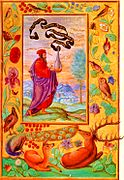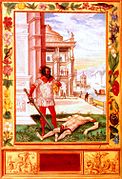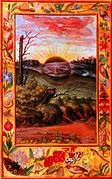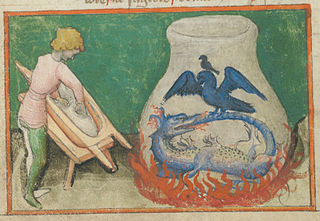
Alchemy is an ancient branch of natural philosophy, a philosophical and protoscientific tradition that was historically practised in China, India, the Muslim world, and Europe. In its Western form, alchemy is first attested in a number of pseudepigraphical texts written in Greco-Roman Egypt during the first few centuries AD.
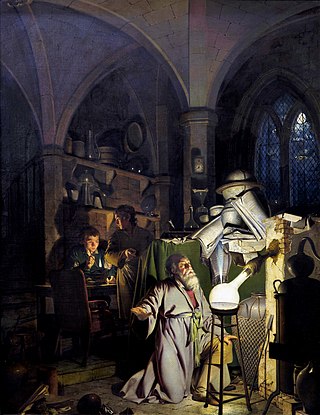
The philosopher's stone is a mythic alchemical substance capable of turning base metals such as mercury into gold or silver. It is also called the elixir of life, useful for rejuvenation and for achieving immortality; for many centuries, it was the most sought-after goal in alchemy. The philosopher's stone was the central symbol of the mystical terminology of alchemy, symbolizing perfection at its finest, divine illumination, and heavenly bliss. Efforts to discover the philosopher's stone were known as the Magnum Opus.

Robert Fludd, also known as Robertus de Fluctibus, was a prominent English Paracelsian physician with both scientific and occult interests. He is remembered as an astrologer, mathematician, cosmologist, Qabalist and Rosicrucian.
The Emerald Tablet, the Smaragdine Table, or the Tabula Smaragdina is a compact and cryptic Hermetic text. It was a highly regarded foundational text for many Islamic and European alchemists. Though attributed to the legendary Hellenistic figure Hermes Trismegistus, the text of the Emerald Tablet first appears in a number of early medieval Arabic sources, the oldest of which dates to the late eighth or early ninth century. It was translated into Latin several times in the twelfth and thirteenth centuries. Numerous interpretations and commentaries followed.
Joscelyn Godwin is a composer, musicologist, and translator, known for his work on ancient music, paganism, and music in the occult.

The Aurora consurgens is an alchemical treatise of the 15th century famous for the rich illuminations that accompany it in some manuscripts. While in the last century, the text has been more commonly referred to as "Pseudo-Aquinas", there are as well arguments in favour of Thomas Aquinas, to whom it has originally been attributed in some manuscripts. The translated title from Latin into English is "Rising dawn."

Zosimos of Panopolis was a Greek alchemist and Gnostic mystic who lived at the end of the 3rd and beginning of the 4th century AD. He was born in Panopolis, and flourished ca. 300. He wrote the oldest known books on alchemy, which he called "Cheirokmeta," using the Greek word for "things made by hand." Pieces of this work survive in the original Greek language and in translations into Syriac or Arabic. He is one of about 40 authors represented in a compendium of alchemical writings that was probably put together in Constantinople in the 7th or 8th century AD, copies of which exist in manuscripts in Venice and Paris. Stephen of Alexandria is another.
Adam McLean is a Scottish writer on alchemical texts and symbolism. In 1978 he founded the Hermetic Journal which he published until 1992 during which time he also started publishing the Magnum Opus Hermetic Sourceworks, a series of 55 editions of key source texts of the hermetic tradition. From 2004 he began collecting tarot cards in order to document tarot art and built up a collection of 2500 items. In 2016 he set up the Surrealism Website in order to document surrealist painters. This currently shows the work of 100 surrealist artists. He also created a series of 20 video lectures on many facets of surrealist paintings. In 2017 he set up an art gallery The Studio and Gallery in Kilbirnie in North Ayrshire in order to promote the work of emergent and lesser-known artists. In 2023 McLean began publishing, in book form, his Alchemical Translations Series of translations of 16-18th Century German, Latin and French alchemical works previously unavailable in English. This project is intended to expand the public's perception of the richness of alchemical literature.

The Rebis is the end product of the alchemical magnum opus or great work.

In alchemical and Hermetic traditions, suns are used to symbolize a variety of concepts, much like the Sun in astrology. Suns can correspond to gold, citrinitas, generative masculine principles, imagery of "the king", or Apollo, the fiery spirit or sulfur, the divine spark in man, nobility, or incorruptibility. Recurring images of specific solar motifs can be found in the form of a "dark" or "black sun", or a green lion devouring the Sun.
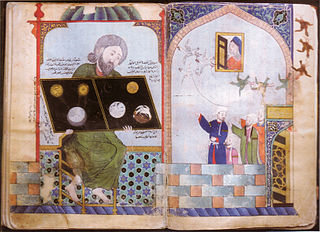
Muḥammad ibn Umayl al-Tamīmī, known in Latin as Senior Zadith, was an early Muslim alchemist who lived from c. 900 to c. 960 AD.
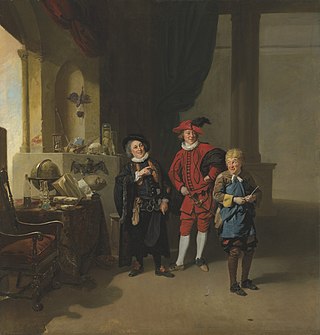
Alchemy has had a long-standing relationship with art, seen both in alchemical texts and in mainstream entertainment. Literary alchemy appears throughout the history of English literature from Shakespeare to modern Fantasy authors. Here, characters or plot structure follow an alchemical magnum opus. In the fourteenth century, Chaucer began a trend of alchemical satire that can still be seen in recent fantasy works like those of Terry Pratchett.

The filius philosophorum is a symbol in alchemy. In some texts it is equated with the philosopher's stone, but in others it assumes its own symbolic meanings. Other terms for the filius philosophorum include filius sapientiae, infans noster, infans solaris, infans lunaris, and infans solaris lunaris.

The Poem of the Right Angle is a series of 19 paintings and corresponding writings composed by the influential Swiss-French architect Le Corbusier between 1947 and 1953 and first published in book format as a limited edition of 250 copies in 1955. Aside from his seminal manifesto Toward an Architecture, The Poem of the Right Angle is considered to be his most lucid synthesis of personal maxims.

Alchemy in the medieval Islamic world refers to both traditional alchemy and early practical chemistry by Muslim scholars in the medieval Islamic world. The word alchemy was derived from the Arabic word كيمياء or kīmiyāʾ and may ultimately derive from the ancient Egyptian word kemi, meaning black.
The following outline is provided as an overview of and topical guide to alchemy:

The Twelve Keys of Basil Valentine is a widely reproduced alchemical book attributed to Basil Valentine. It was first published in 1599 by Johann Thölde who is likely the book's true author. It is presented as a sequence of alchemical operations encoded allegorically in words, to which images have been added. The first Basil Valentine book to discuss the keys is Ein kurtz summarischer Tractat, von dem grossen Stein der Uralten, 1599.

The Sola Busca tarot is the earliest completely extant example of a 78-card tarot deck. It is also the earliest tarot deck in which all the plain suit cards are illustrated and it is also the earliest tarot deck in which the trump card illustrations deviate from the classic tarot iconography. Unlike the earlier Visconti-Sforza tarot decks, the cards of the Sola Busca are numbered. The trump cards have Roman numerals while the pips of the plain suits have Arabic numerals.The deck was created by an unknown artist and engraved onto metal in the late 15th century. A single complete hand-painted deck is known to exist, along with 35 uncolored cards held by various museums. The deck is notable not only for its age, but also for the quality of its artwork, which is characterized by expressive figures engraved with precise contours and shading. Various theories have been suggested about who created the deck, but its authorship remains uncertain.
Andrea Aromatico is an Italian writer and expert in Hermetic iconography and esotericism.
Solomon or Salomon Trismosin was a legendary Renaissance alchemist, claimed possessor of the philosopher's stone and teacher of Paracelsus. He is best known as the author of the alchemical works Splendor Solis and Aureum Vellus.

